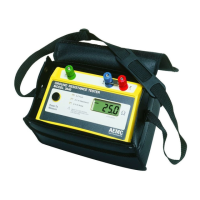16
Digital Ground Resistance Tester Model 3640 and 4610
TheNEC
®
2008250.52(A)(5)requiresaminimumof8ft(2.4m)tobein
contactwiththesoil.Themostcommonisa10ft(3m)cylindricalrodwhich
meetstheNEC
®
code.Aminimumdiameterof5/8"(1.59cm)isrequired
forsteelrodsand1/2"(1.27cm)forcopperorcoppercladsteelrodsNEC
®
2008250.52(A)(5)(a)(b).Minimumpracticaldiameterfordrivinglimitations
for10ft(3m)rodsare:
• 1/2"(1.27cm)inaveragesoil
• 5/8"(1.59cminmoistsoil
• 3/4"(1.91cm)inhardsoilormorethan10ftdrivingdepths
4.1.2 Effects of Soil Resistivity on Ground Electrode Resistance
Dwight’sformula, cited previously,shows that the resistanceto earth of
groundingelectrodesdependsnotonlyonthedepthandsurfaceareaof
groundingelectrodesbutonsoilresistivityaswell.
Soilresistivityisthekeyfactorthatdetermineswhattheresistanceofa
groundingelectrodewillbe,andtowhatdepthitmustbedriventoobtain
lowgroundresistance.
Theresistivityofthesoilvarieswidelythroughouttheworldandchanges
seasonally.Soilresistivityisdeterminedlargelybyitscontentofelectro-
lytes,consistingofmoisture,mineralsanddissolvedsalts.Adrysoilhas
highresistivityifitcontainsnosolublesalts.
Soil
Ashes, cinders, brine, waste
Clay, shale, gumbo, loam
Same, with varying proportions
of sand and gravel
Gravel, sand, stones with
little clay or loam
590
340
1,020
59,000
2,370
4,060
15,800
94,000
7,000
16,300
135,000
458,000
Resistivity, Ω-cm
Minimum Average Maximum
Table 1

